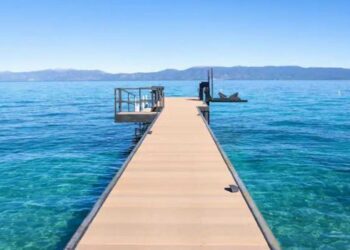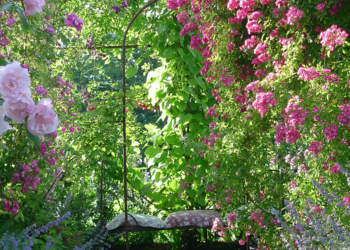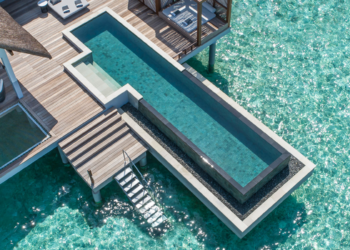I’ve been to the continent of Africa over 30 times. I went on my first trip when I was 23 to the Ivory Coast (Côte d’Ivoire) and have returned almost every year, often multiple times. There are 54 countries in Africa and I’ve been lucky enough to visit 16—Botswana, Côte d’Ivoire, Egypt, Kenya (over and over again), Malawi, Mauritius, Morocco, Namibia, Seychelles, South Africa, Tanzania, Tunisia, Uganda (where I first trekked with mountain gorillas), Zambia, Zimbabwe and Rwanda, where I recently returned to again experience the thrill of trekking with their mountain gorillas. Here I share my life-affirming journey.
Add Rwanda to Your Bucketlist

Known as the land of a thousand hills, Rwanda’s scenery is simply stunning and the people are warm, gracious, and beyond hospitable. The African nation is renowned for its unique biodiversity, here you’ll find incredible wildlife living throughout its volcanoes, montane rainforest, and sweeping plains. And while travelers come from all over the world to see the gorillas, there’s plenty more to see in Rwanda. The country is blessed with four national parks—each one well worth a visit. And since the country isn’t overly large and the roads are good, I was driven to each attraction and sight worth traveling for.
Day 1

I wanted to pack as much into my visit to Rwanda as possible, so I hit the ground running on day one. I started with a city tour of Kigali to get a lay of the land and stopped at a few markets. Next, I went to the Genocide Memorial, where I learned more about the horrific history of the 1994 genocide in Rwanda but also had the privilege of speaking with people who lived through it. What was so amazing is that the people of Rwanda actively embrace peace and reconciliation. The deeply moving memorial educates those within the country and travelers through testimonies by those who survived the genocide but tragically lost loved ones. If you’re traveling to Rwanda, this is an important place to visit to understand and reflect on how we all have a personal responsibility to prevent discrimination and mass atrocity.
Day 2

From Kigali, I went to Nyanza, home of the King’s Palace. It’s a reconstruction of the traditional royal residence, a thatched dwelling shaped like a beehive. Here I learned the history of Rwanda’s kings. King Musinga Yuhi V made Nyanza the first permanent royal capital of Rwanda in 1899 and it kept this status until the country became a republic in 1962. The highlight of the visit, however, was seeing the long-horned Ankole cattle, descended from the king’s herd, whose keepers lovely tend to and sing to them. The cattle are amazing to see—with their massive horns—and it’s amazing to see the keepers play their flute and sing to these peaceful creatures.
From Nyanza and I drove to Nyungwe National Park, which is one of the oldest rainforests in Africa. This park is known for its chimpanzee tours as well as its various hiking trails. I embarked on the Canopy Walkway, which involves crossing a 160m long and 70m high suspension bridge that looks down into the montane rainforest. The guided tour along the Igishigishigi trail was a great way to prepare for my upcoming gorilla trek. Along the trail, we saw many birds. There are also 13 species of primate in Nyungwe, so a chance encounter isn’t out of the question, although it’s best to book a primate-specific trip to increase the chance of seeing them.
Day 3

Because there is so much to see in Nyungwe National Park, two days are really needed to explore this area properly. A great hike is the Ndambarare waterfall trek. The hike down to the falls is relatively easy, but the hike back up is a good workout but the views of the falls are so stunning, it’s worth the achy legs. Be sure to leave time to also do the colobus monkey trek. Several hundred of Nyungwe Forest’s troops of Rwenzori black-and-white colobus monkeys, the largest population anywhere in Africa can be seen up-close with a guide. Be sure to wear proper footwear and clothing as the guides bushwhack into the forest to find the monkeys. I walked down steep and slippery muddy paths but was rewarded by unforgettable encounters with these primates.
Day 4

I headed to Lake Kivu, which is part of Africa’s Great Rift Valley, where I went kayaking at sunset on Lake Kivu, a stunning way to experience and get a sense of the region. From here I took a boat ride to the Kinunu coffee plantation for a fascinating inside view of how coffee is produced in Rwanda. Since the introduction of coffee trees to Rwanda by missionaries in 1904, coffee has become one of the country’s largest cash crops. There are about 450,000 small growers producing coffee all across Rwanda, but tourist visits are primarily centered around Gisenyi, near the shores of Lake Kivu. The coffee-covered hillsides shimmer green throughout the year, with the coffee cherries turning a deep cranberry red when the harvest is ready, usually between February and May. Once collected, the beans are taken to washing stations, where they are sorted by hand, pulped, fermented, and graded. They are then dried in the sun on raised screens before being taken for milling. This is well worth a visit to understand why coffee is one of Rwanda’s most important exports.
Day 5

Gorilla trekking day! There are only three places in the world to see mountain gorillas: Rwanda, Uganda, and the Democratic Republic of the Congo. There are approximately 1,000 mountain gorillas in the wild, with 604 in the Virunga Massif. 12 gorilla families live in Volcanoes National Park, with each troop consisting of at least one silverback along with several females and juveniles. The chance to see gorillas in their natural habitat is one of the most exhilarating intimate experiences travelers can have. Encounters with gorillas as they go about their daily lives are carefully managed, with expert trackers and guides leading small groups of eight up bamboo-covered slopes to spend an hour, just feet away from these gentle majestic creatures.
We arrived at Volcanoes National Park headquarters in Kinigi at 7 am. The guides look at the group as a whole to see if they should do the easy, moderate, or difficult hike, and based on this you are assigned a gorilla family: Either Susa, Igisha, Karisimbi, Sabyinyo, Amahoro, Agashya, Kwitonda, Umubano, Hirwa, Bwenge, Ugyenda, and Muhoza. Hikes to find the gorilla can range from 30 minutes to over four hours. The hiking was steep and muddy, but not overly strenuous (we were in the moderate fitness level group). The trackers go out in advance, while the guides go with the tourists and they are in constant contact. Everyone is offered a porter at the beginning of the trip (around USD 10 and well worth it), and they will carry backpack and camera equipment, and give you a hand navigating the more tricky parts of the trail. I tipped my fabulous porter $20 tip (best money I’ve ever spent), do tip the guides and trackers.

We finally found the gorillas after hiking for two hours and spent an hour in their company (the time goes too quickly). I took many photos, before putting my camera away and just enjoyed being present with these amazing creatures. The little ones were playful, doing somersaults, and rolling around. The silverback pounded his chest a few times to show dominance and then climbed a tree. While our guides kept us a good distance, the animals could go where they wanted and several walked near me and looked at me inquisitively (they are fully habituated to people). Seeing the family dynamic was truly amazing and none of us wanted to leave, ever.
Day 6

After trekking with the mountain gorillas in Volcanoes National Park, we headed to Akagera National Park in Eastern Rwanda. At Akagera the topography is savannah, woodland, and wetland. People generally go to Akagera after trekking with the gorillas to go on safari to see the Big Five on game drives. Here we were thrilled to see elephants, giraffes, zebras, hippos, lions, cape buffalo, and warthogs. All in all a truly life-changing experience.
Insider Tips
- Currently, travelers need to have a negative covid test within 72 hours of visiting each national park. Masks are worn when visiting the gorillas.
- Gorilla trekking requires tickets/permits and these should be booked as far in advance as possible.
- Rwanda’s newest national park, the fourth in the country is Gishwati Mukura National Park and it’s a great place to book a chimpanzee trek (versus Nyungwe National Park which is often booked out). Chimp trekking also requires a ticket/permit.
- Dress appropriately for trekking including a good pair of hiking boots and light-weight, quick-drying long pants, and travel light.
- Bring cash for tips for the trekking guides.
- By trekking with gorillas, you will be supporting the local community. 10% of the revenue from all permits goes towards initiatives like building schools, health centers, and roads. The experience also employs many locals as rangers, trackers, porters, drivers, and tourist lodge staff. There is a compensation fund for local farmers should any gorillas damage their crops.
MEET THE AUTHOR
Judy Koutsky is a New-York based writer who has visited all seven continents around the globe, Africa being a favorite. Her work has appeared in over 30 publications including Conde Nast Traveler, Travel + Leisure, Forbes, Afar, and Robb Report.







